Two Moscow in one frame
Categories: History | Photo project
By Pictolic https://pictolic.com/article/two-moscow-in-one-frame.htmlKonstantin Konovalov, an animator from Moscow, conducts a photo project "Two Moscow" about the historical appearance of the city in his spare time. The essence of the project is to combine photographs of the present time with historical photographs of the same place. He accompanies each photo with a small note telling about the history of the photographed place.
To immerse yourself in another era, you need to find exactly the position for the picture that the photographer chose several decades ago. All the pictures are taken on the iPad and combined with the old ones on it, right on the shooting site. Which, according to the author, allows you to forget about the special processing of photos on a computer and brings ordinary users of the same Instagram closer to such cognitive entertainment.
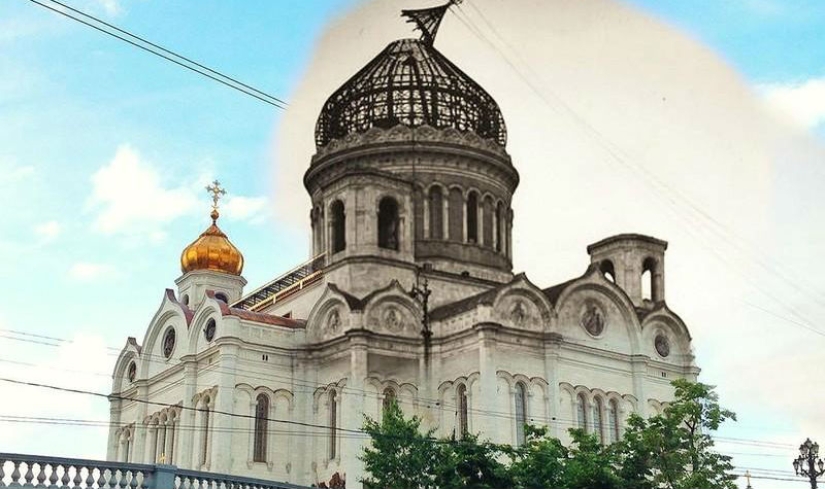

The KGB building is perhaps the most terrible building in Moscow (many people were shot there, and the security forces of our country have been sitting there for almost a century).
At first, a neoclassical building was built for the insurance company "Russia", but it was given to the NKVD already in 1919. Then, when it was necessary to enlarge the internal prison for political prisoners, the building was expanded, adding a new building in the style of constructivism to it. The building became asymmetrical and stood like that for almost half a century. And then the original facade was built up, making the building symmetrical in the 80s. If you open Google Maps, you will see that the building from above is not symmetrical at all, and is located in the place where Malaya Lubyanka Street should be.
There was a monument to Dzerzhinsky in front of the building. Now it is gone, but the place in the center of Lubyanka Square for the monument remains and looks strange. And no one knows which monument can be put there, because it is unethical to put a poet in front of a "bloody" building. And monuments to Soviet leaders have not been erected for a long time, but there were rumors about a monument to Gagarin.

Back in 1931. Demolition of the Cathedral of Christ the Savior / Our days.
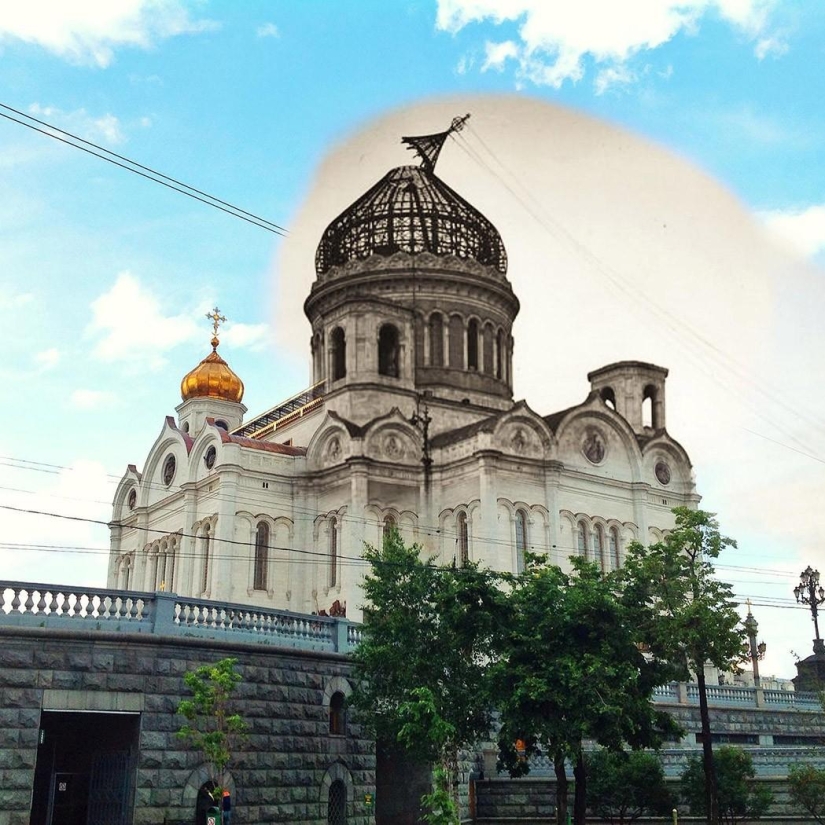
Manezhnaya Square and Okhotny Ryad.
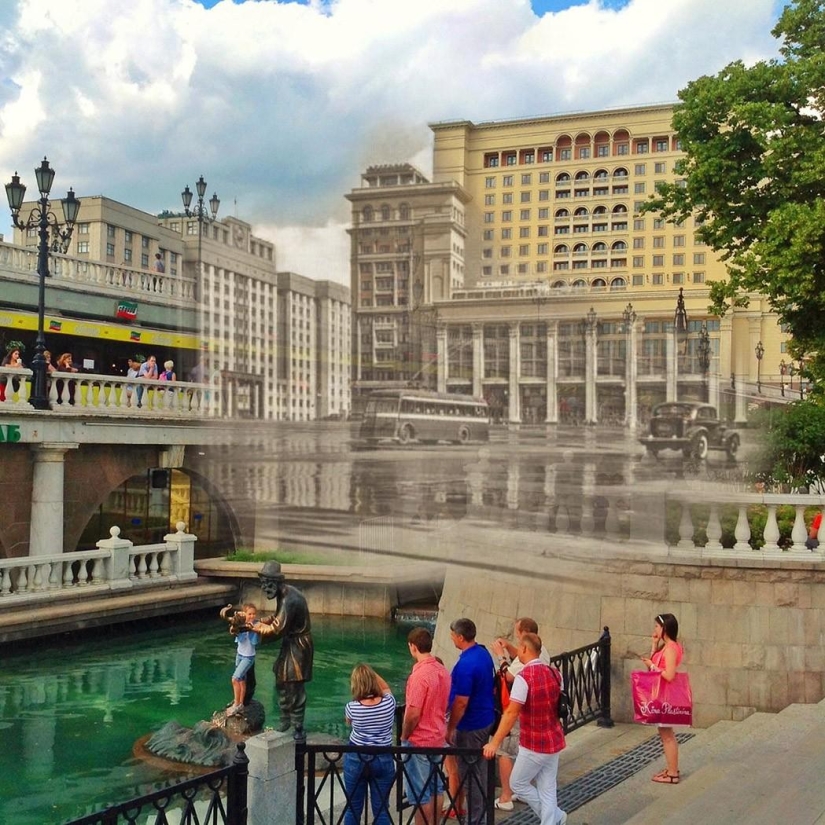
The Big Stone Bridge.
I was insanely inspired by the architecture of this bridge. Moscow lacks such beautiful designs. Modern bridges do not fit into the ensemble of the Kremlin and the historical part of the city.
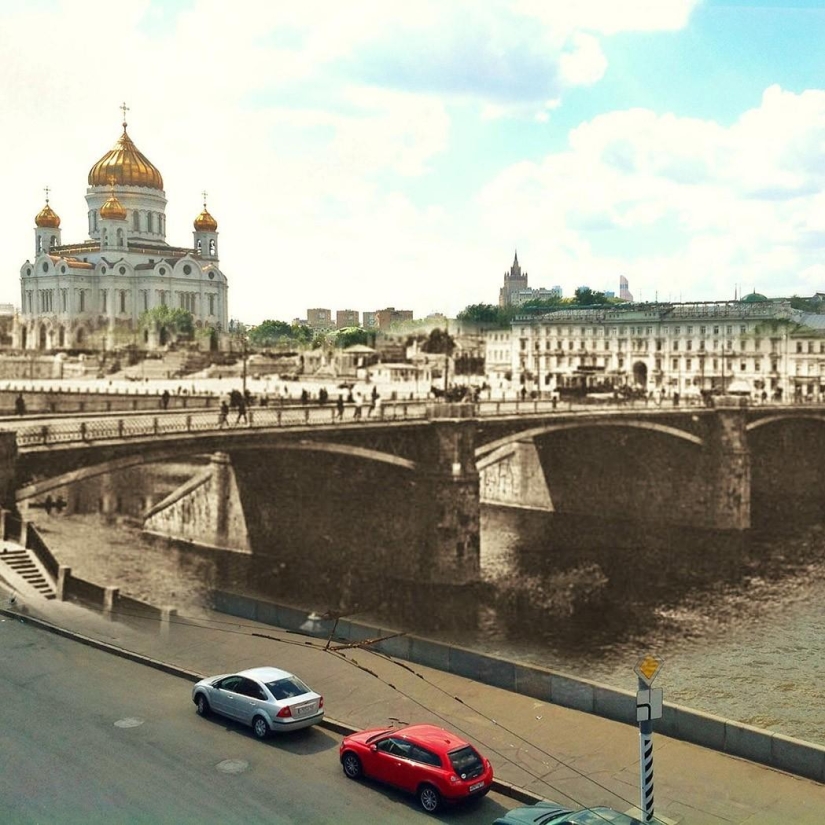
Sukharevskaya Tower (view from Sretenka).
Sukharevskaya Tower. Peter the Great ordered it to be built in 1692, and Stalin ordered it to be demolished in 1934. It was decided to demolish it because of the now popular problem - the growing street traffic. It stood at the intersection of the Garden Ring and Sretenka Street. The year 1931 is remarkable in the photo.
Great painters and architects sent Stalin a letter:
"Sukharev Tower is an unfading example of the great art of construction, known to the whole world and equally highly valued everywhere. Despite all the latest achievements of technology, it still has not lost its enormous demonstrative and educational value for construction personnel." "We... strongly object to the destruction of a highly talented work of art, equivalent to the destruction of a Raphael painting. In this case, we are not talking about the breaking of an odious monument of the era of feudalism, but about the death of the creative thought of the great master."
But they did not convince Stalin… I wonder what Sretenka would look like and The Garden Ring now, with the current traffic, if the tower had been preserved?
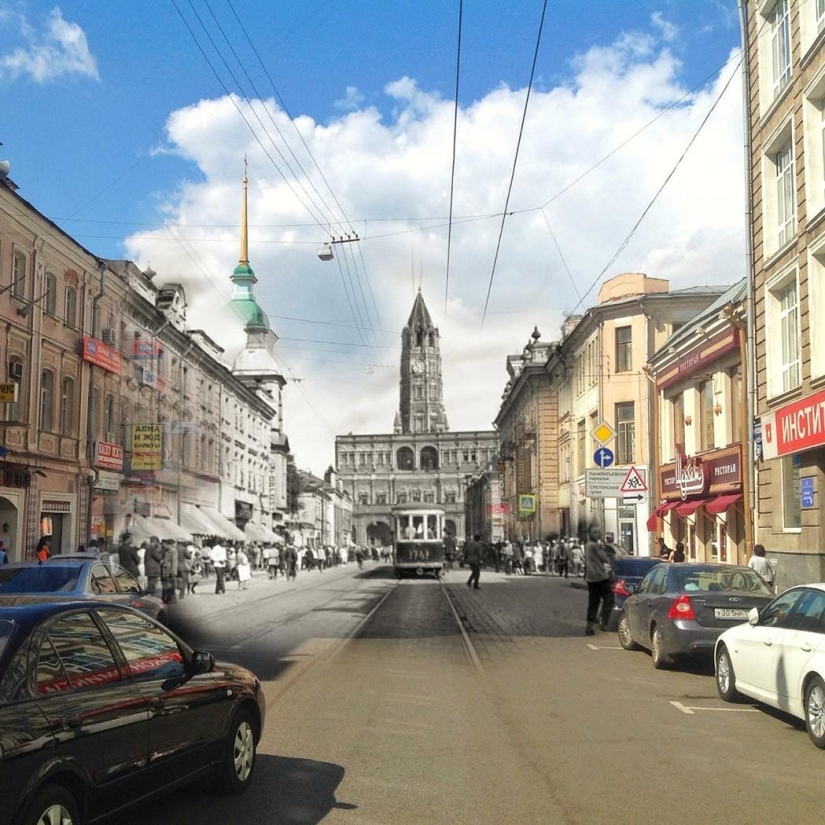
The Arc de Triomphe.
In 1936, as well as the Sukharevskaya Tower, the arch was dismantled as part of the reconstruction of the square, although it was promised to be restored at the same place, but it was not restored. More precisely, it was restored, but where it is now installed, and 30 years later. We like to break, and then build again! The arch is dedicated to the victory over Napoleon.
Separately, I would like to say that I was very surprised that the railing of the bridge over the railway of the Belarusian direction, from which I took the picture, remained unchanged.
And it's an amazing feeling when you find yourself at exactly the point from which a person took a picture with his camera almost a century ago, and you're standing here with an iPad and photographing the same panorama, but in the center of the frame there is no longer that splendor for which that person with the camera came here. It's hard to describe it, but try it yourself!

Barbarian Gate Tower.
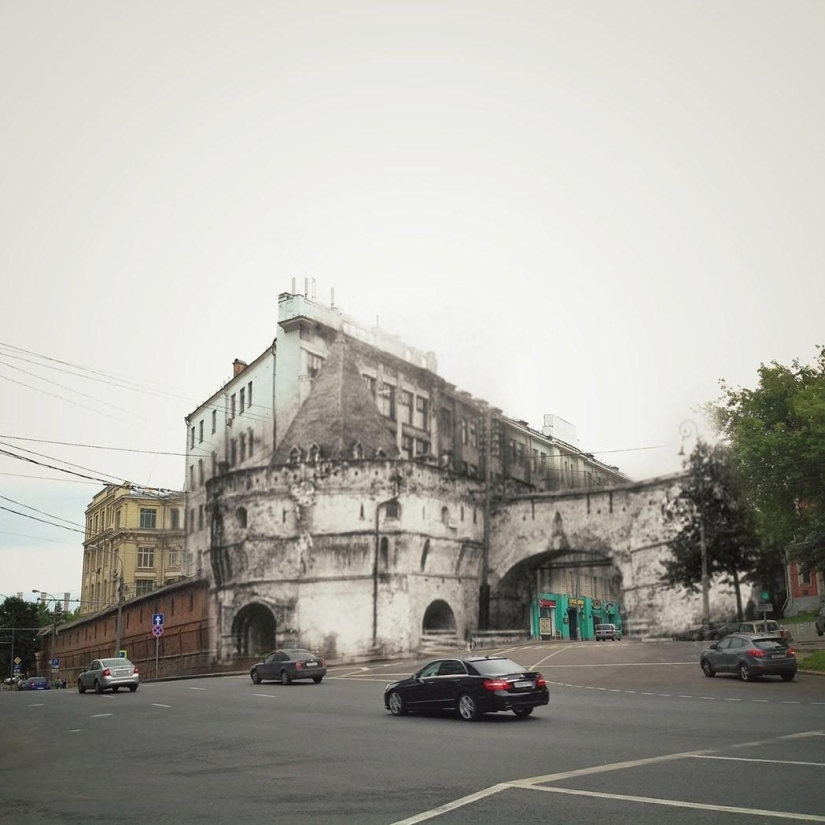
Ilyinsky Gate.
After the demolition of the gates, the Ilyinsky Gate Square was named after them. They also wanted to name the metro station, but decided not to build the station. Have you noticed that there is too much distance between Revolution Square and Kursk? That's exactly where the Ilyinsky Gate station was supposed to be.
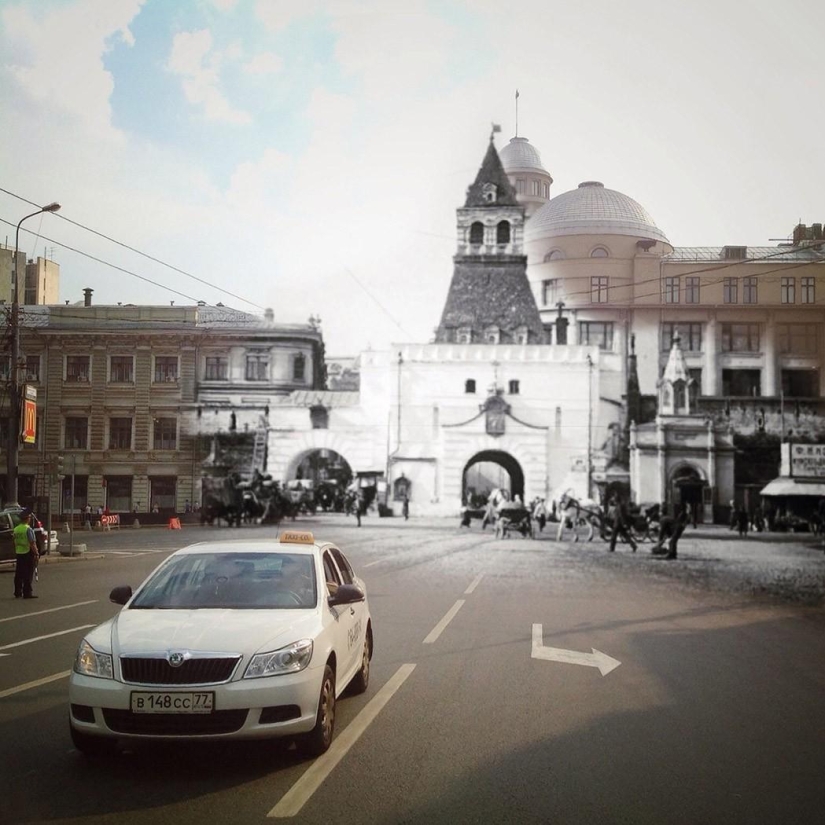
Vladimir Gate.
I studied the preserved photographs for a long time and found a photograph showing the top of the Tretyakov Gate and the glass dome of the Metropol Hotel. With the help of these two landmarks and their intersection in the photo, I already had the line from which the picture was taken, but there was still some clue missing. It became the top of an apartment building on Nikolskaya, 21 and the angle of inclination of Nikolskaya Street itself. Of course, there is some error here, but it is unlikely that it will be possible to recreate it more accurately. I made a sketch on the map, determined the shooting point, and went to shoot. As a result, it turns out that the gate was located where the roadway is now (the turn from the Theater Passage to the New Square). On the site where the Lubyanka station lobby is now, there used to be a church of the Vladimir Mother of God, and on the site of the Nautilus shopping center there was a beautiful chapel of Panteleimon the Healer (in the photo). In general, Lubyanka Square used to be not as big as it is now.
The tower, as well as at the Ilyinsky Gate, is similar to the Kremlin, since it was restored in this style after the fire of 1812. Vladimir Gate was the second-hand book center of the city. Most of the bookstores were located right here. They were located in the Nikolsky Cul-de-sac. It was so named because it rested against the Kitaygorodsky wall, but then a small gate was made in the wall so that people from the theater passage could run into the bookstore. Almost all the houses here were destroyed in 1934. So the Nikolsky dead end is now an imaginary place.
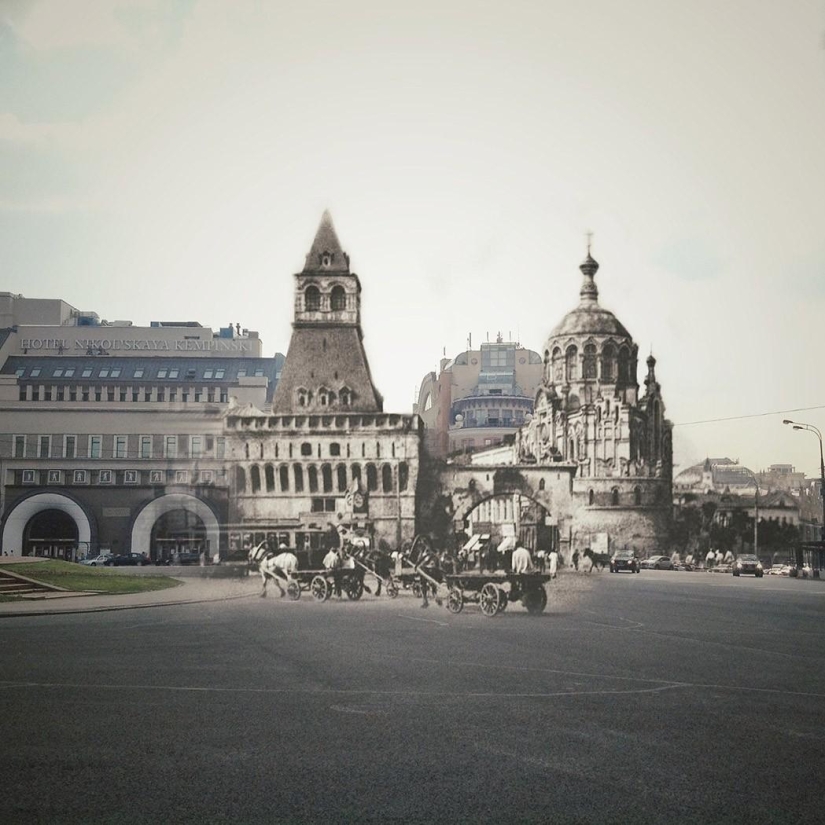
The Resurrection (Iversky) gate and the zero kilometer.
The gate was built in 1680, destroyed in 1931 by order of Stalin, because vehicles had to go to Red Square, and military equipment did not pass through such narrow gates. For a long time there was a roadway here, which was called in honor of the Historical Museum — the Historical Passage, just like it is in the photo. Luzhkov restored them in 1994! And I made a pedestrian zone here.
There is a kilometer zero in front of the gate. It was installed not so long ago — in 1995. Here tourists throw coins over their left shoulder. But in fact, this is not a zero kilometer. The real kilometer zero is located near the central telegraph building. It's just that in Soviet times they wanted to install it in front of the mausoleum, but they didn't do it, and a bronze sign was made and in the nineties they installed it at the restored Resurrection Gate just like that. In Paris, for example, the zero kilometer is located at Notre Dame de Paris.
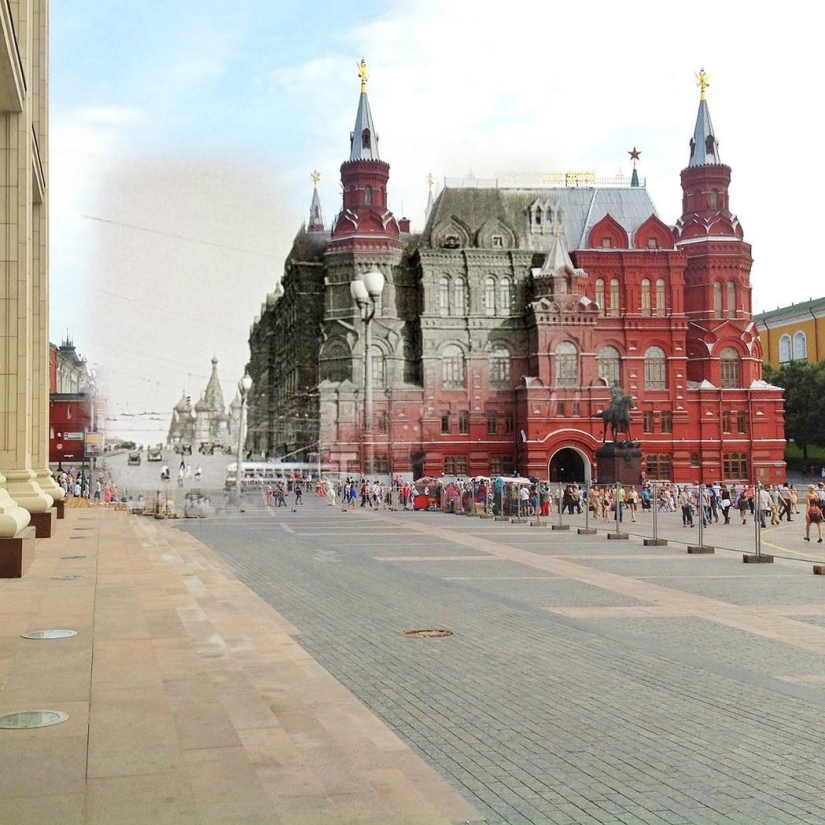
The house is under the skirt.
There is also a legend that the ballerina Lepeshinskaya, in whose image the sculpture was made, broke her arm and the sculpture's arm immediately fell off. After that, they made a complete dismantling, fearing the fall of other body parts on passers-by.
It was not possible to find large photographs of this sculpture, although it stood for almost 20 years and was very noticeable. I think the sculpture of a ballerina on the roof of a house is much better than the glowing logos that have flooded the roofs of the whole of Moscow.
By the way, the church of Dmitry Solunsky stood on the site of this house until 1933.
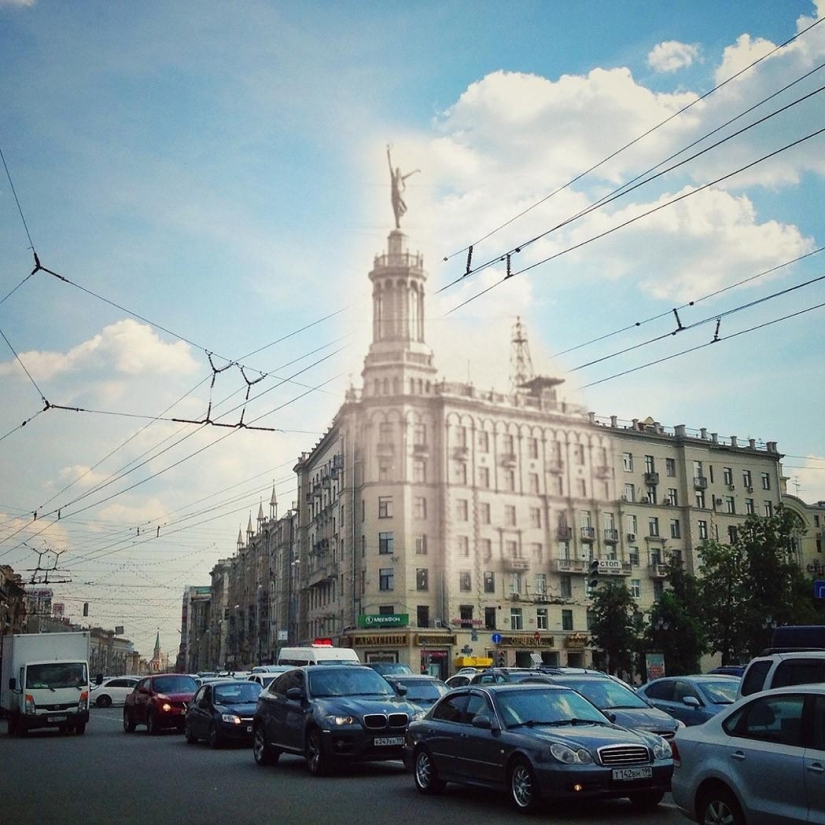
The lobby of the metro station Kominterna Street
The metro station Kominterna Street was part of the first Moscow metro. Through its lobby it was possible to go down to the Lenin Library station, but there was no transfer between the two stations initially.
The station was also called "Kalininskaya" (from 1946 to 1990). A few days in 1990, it was called "Vozdvizhenka", and even managed to put this name on the metro schemes.
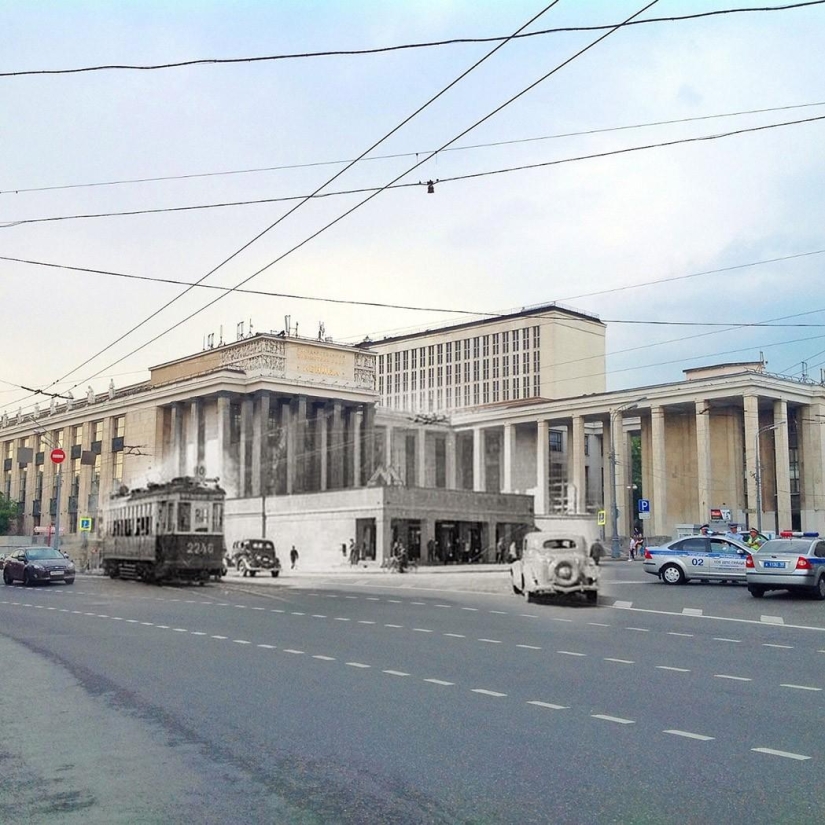
Red gate.
By the way, this place is directly connected with Lermontov. He was born in a neighboring house — now the Stalin high-rise is located on the site of this house. From 1962 to 1986, the square was called Lermontovskaya. The name of the metro station during this period was also changed to Lermontovskaya. And the monument to Lermontov stands nearby.
It was difficult to find the exact position of the gate. We can say that in this photo it is approximate, because almost all the houses around were built in the 30s, when the gates were no longer there. But I was guided by the position of streets and corner buildings. The gate was located on the site of the inner lane of the Garden Ring. A sculpture of an angel has been preserved from the gate, it is kept in the Historical Museum.
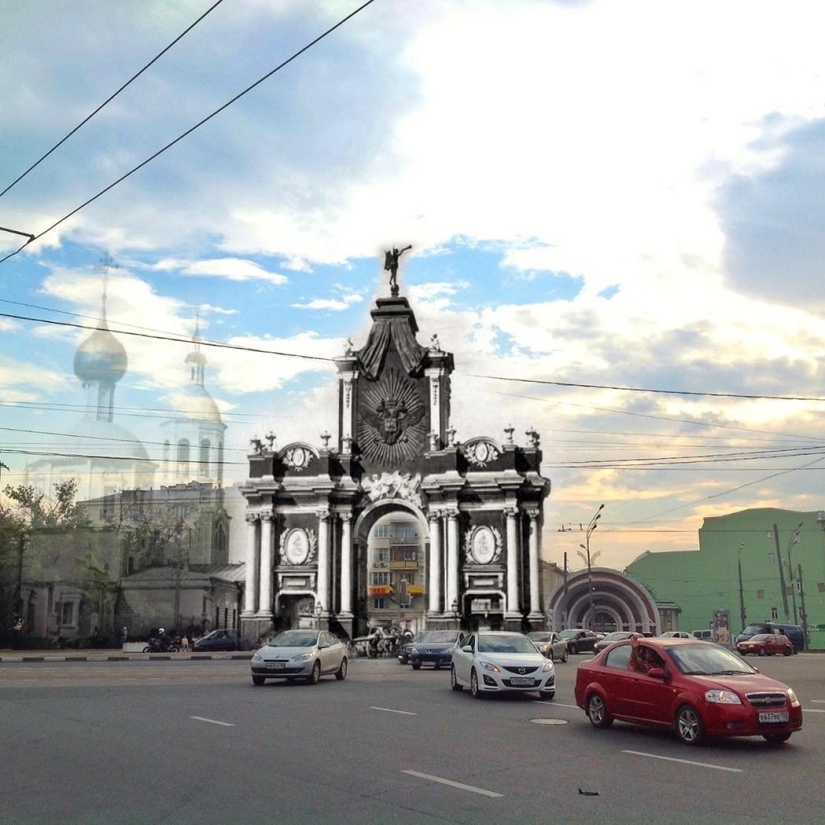
Vasilievsky Descent.
If we turn to the history of the Moscow metro, it was originally planned to lay a subway here. But not underground, but above, almost like the monorail in the north of Moscow now. The idea is grandiose, perhaps all the houses were demolished to implement it. A station with the same name "Red Square" was planned on Red Square. But the plans for the construction of the metro changed many times, and this project was abandoned.
This place is also famous for the fact that in 1987, the German aviation enthusiast Mathias Rust landed here, questioning the inviolability of defense. After this event, Muscovites often joked, giving Red Square and Vasilievsky Descent the name "Sheremetyevo-3".
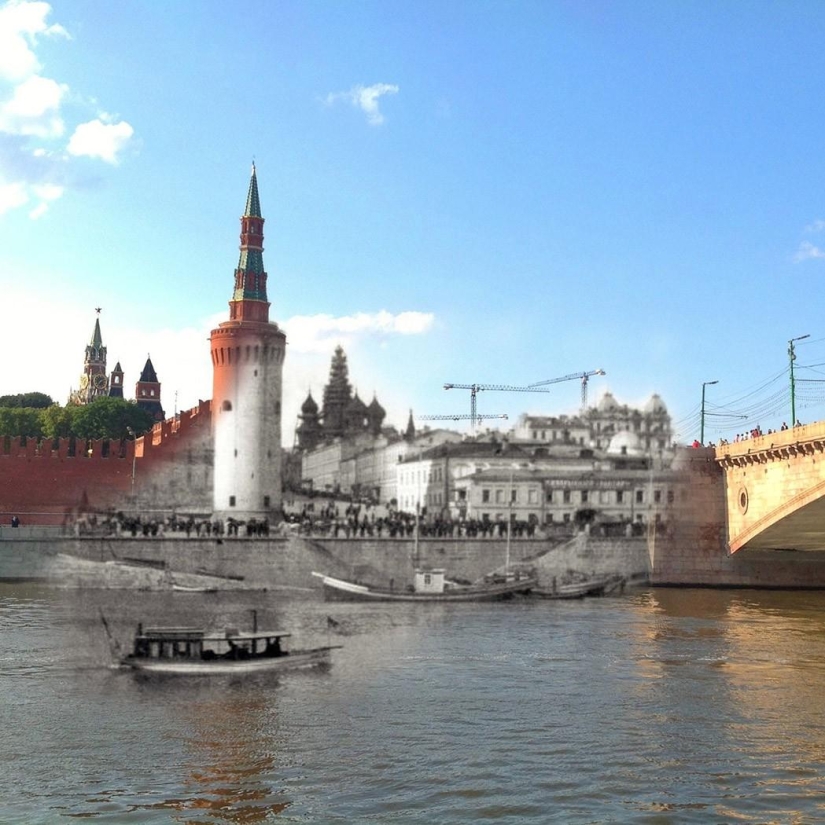
High-rise building on Kotelnicheskaya embankment.
Interestingly, Building A, and then the skyscraper itself, after some time, was designed by the same architect Chechulin. This is one of the most striking examples of the superstructure of houses in Moscow. In the building, And until the 2000s there were communal apartments. For fire safety purposes, there was a door to the next apartment in the corridors of each apartment, so the whole house could be passed through.
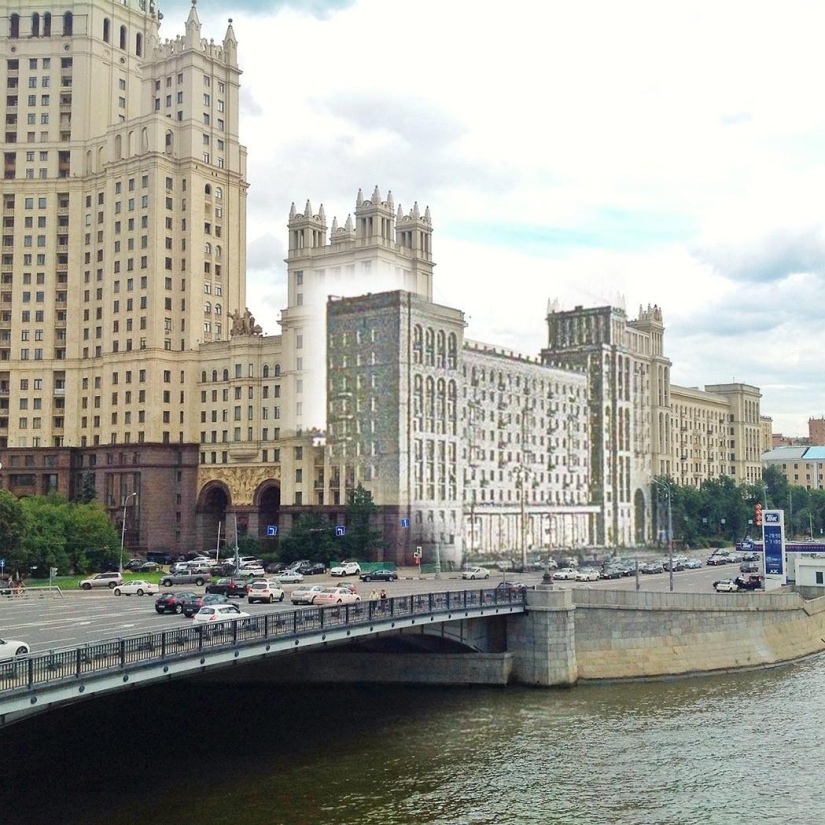
Monument to Gogol.
Disputes over the monument to Gogol were conducted all the time. Some people considered the first monument very deep and showing serious emotional experiences of the writer, and the other part of society did not understand why the great Russian writer was so crouched and why he should be portrayed like that at all. I liked Vrubel's statement about the 1909 monument: "We don't put up monuments for one day. It didn't come today, it will come in ten years!.. It is criminal to hide such an exceptionally talented work under a bushel!.."
Interestingly, the first monument was erected on the centenary of Gogol's birth, and the second on the centenary of his death. But the lions under the lanterns around the monument survived both Gogols - both sad and cheerful. And which monument to Gogol do you like?
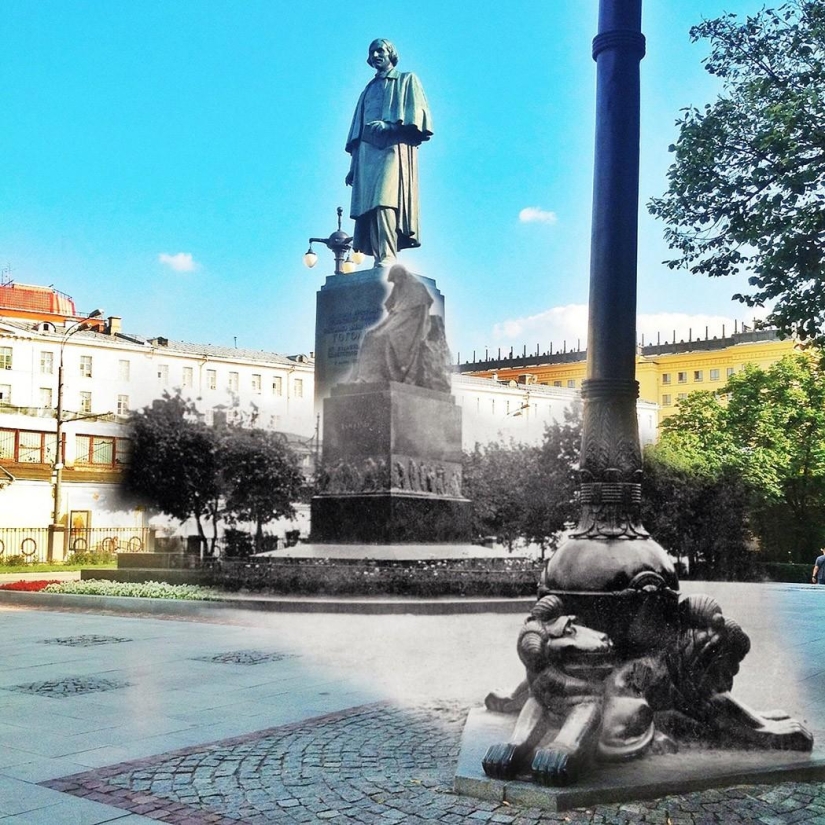
A worker and a collective farmer.
It is also worth noting that the Eiffel Tower was also originally created only for the exhibition in 1889, but now it has become the main symbol of Paris. The photos show a pavilion with a sculpture in Paris, it was located on the banks of the Seine near the Yen Bridge, on Tokyo Avenue (now New York Avenue).
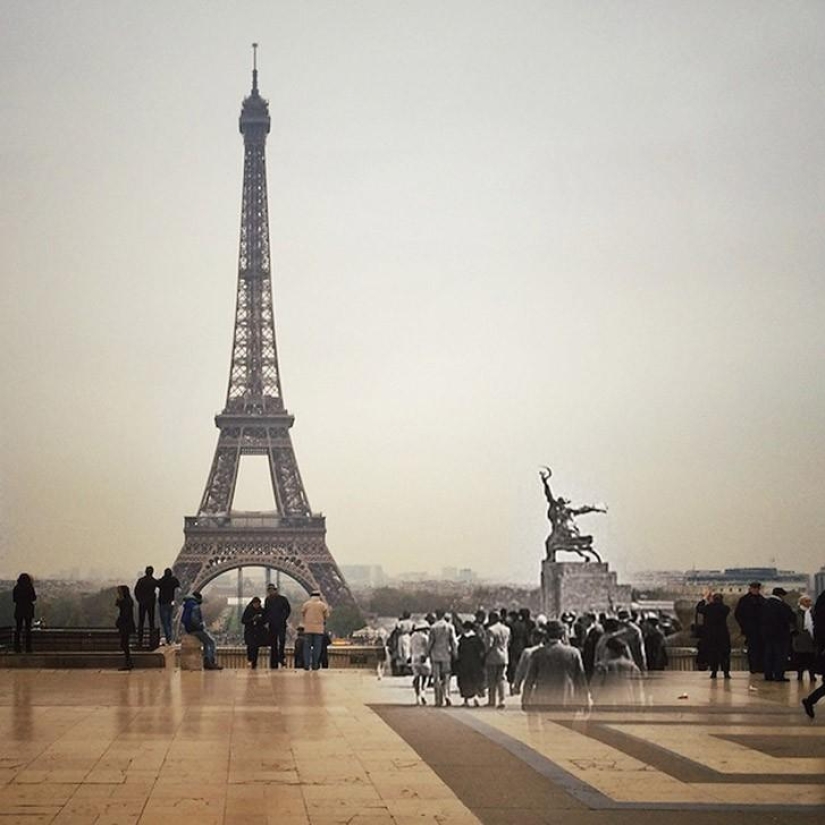
Pushkin (Andreevsky) pedestrian bridge.
Now the bridge is pedestrian and connects Gorky Park and Neskuchny Garden with Frunzenskaya Embankment. But initially it was located just upstream — where two new bridges now stand: the Novoandreevsky Railway Bridge and the Andreevsky Automobile Bridge, which is part of the TTK. In 1999, the Andreevsky Bridge was moved due to the fact that it could no longer cope with its railway duties, but at the same time it was an important monument of engineering thought. The preparation for the transfer took about six months, and his very transfer to a new place by water took only an hour and a half.
Officially, it is believed that this is a new bridge and is called Pushkin, and it was built on the basis of the main arch of the Andreevsky Bridge, but the townspeople used to call it Andreevsky, even on some maps it is designated that way, and the sign on the bridge itself calls it Andreevsky. Of course, the bridge changed during the transfer. The Moscow River is wider in this place than in the previous one, so another span appeared from the Frunzenskaya Embankment. And the bridge itself was glazed, making it a shelter from the rain for those walking in the park.
A similar story happened with the Krasnoluzhsky railway bridge, which was built by the same architects. It was moved to the Kiev railway station and called the Bogdan Khmelnitsky Bridge, but this is a separate story.

Tchaikovsky Concert Hall - Omon Theater.
This theater was called the hearth of immorality, but at the same time the delight of the general public in Moscow did not subside. Performances took place here from 7 to 11 pm. After the performance, the audience could invite the girls who performed to dinner or to the "offices". According to the rules of the theater, the girls had to agree to all the suggestions of visitors and stay in the theater until 4 am, until everyone dispersed. It is also important to say that in 1902 the first film screening took place here in Russia with the help of a biophonograph, the predecessor of sound cinema. In 1907 , the riot police left Russia in Paris, either because of large debts, or being afraid of the revolution, eventually became the administrator of the Moulin Rouge — the most famous cabaret in the world.
Now the building is no longer recognizable. Inside it was greatly rebuilt by Meyerhold, who wanted to make his own theater here. But in 1939, Meyerhold was shot, and the facade of the building was completed by architect Chechulin. Visually, the building has increased due to the attached lobby of the Mayakovskaya station.
Since 1940, the building has housed the Moscow Philharmonic. But, despite the large-scale reconstruction of the building, we can still see the windows and columns left over from the original project. The Omon Theater had only four main floors, so there are simply no windows on the modern facade above the colonnade, and it looks strange, especially if you take into account the presence of windows in the attached part with the metro lobby (the left part of the building in the photo).

The Theater of Satire is the Nikitins' Circus.
And the thing is that initially there was a circus of the Nikitin brothers on this place, which was rebuilt in Soviet times, first bricking up all the windows, and later completely covering the beautiful facade with a "concrete box". The only thing that now reminds us of the circus that was here is the dome, which was also slightly altered, apparently expanding it to strengthen the structure.
Three brothers - Dmitry, Akim and Peter Nikitins were pioneers of Russian circus art. They were born in the family of an ordinary serf peasant in Saratov and from childhood began to participate in street performances. During their lifetime, they built about 30 circuses across the country. And the brothers also built hospitals, baths and shelters free of charge, thanks to a rather large income from their circus activities.
But here is just the circus, built in 1911 on The Triumphal Square, which we are talking about today, closed in the mid-20s due to lack of funds. Even for the maintenance of animals there was no money. But by this time, all three brothers had already died.
After the destruction of the circus, the building housed a Music hall, and then an Operetta theater. The Satire Theater moved here only in 1965 from the opposite side of the street. In the same year, the work on turning the wonderful work of architect Nilus into a dubious "concrete box" was completed.
Keywords: City | Moscow | Then and now
Post News ArticleRecent articles

Most of us loved as kids magic tricks, but someone loves them right now. However, the attitude to the hoax became a few others ...

Everything is changing. This is well and has long been known to everyone. But when something stays with you for a long time, it is ...
Related articles

That looked like famous actors of the Soviet screen in the childhood years. Unfortunately, many archived images are preserved not ...

If you like peace and privacy, it is unlikely that you will choose a metropolis, going on vacation. Especially when in the world ...

It is now the so-called Khrushchevki khayut and threaten to level with the ground. And 50 years ago, these squat houses saved the ...

Compared to the 1970-ies 1980‑e years were a time of cautious optimism in new York. Boom on wall street fueled the speculative ...